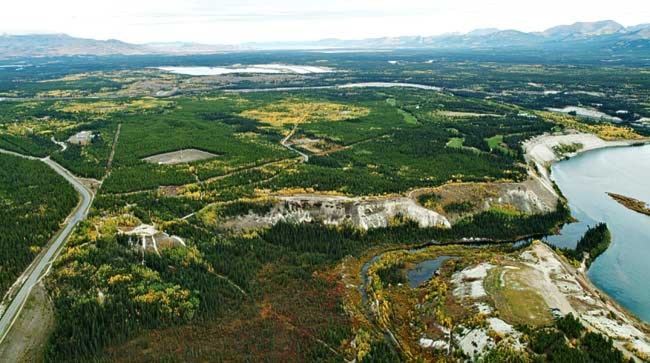Sewage pipes may soon be heating the homes of Yukoners.
Every time you flush a toilet, human refuse is not the only thing you’re discarding. You’re also flushing down litres of valuable, room-temperature water. By simply wrapping sewage pipes with a specialized “heat exchanger,” you can recapture this otherwise-lost energy, and, using a network of antifreeze-filled heating pipes, reroute it into specialized home-heating furnaces.
Presto! Home heating from sewage pipes.
It’s the principle of geoexchange - a cutting-edge heating alternative being examined for the city’s new Whistle Bend subdivision - and an innovative approach to energy use that may see the heating bills of future Whistle Bend residents slashed by up to 50 per cent.
Of course, sewage pipes aren’t the only hiding places for home heating - they’re just the beginning. The very soil around us is jammed with vast stores of heat far more valuable than the gold that once dwelled within it.
Holes may soon be sunk into the area around Whistle Bend, primed to collect ground heat and channel it into the heating systems of hundreds of homes. Aside from holes, underground trenches and groundwater sources are popular geoexchange sources.
And you wouldn’t even know they were there.
Since geoexchange sources are all underground, they can be easily hidden beneath a building or parking lot. A sharp contrast to smoke-spewing chimneys, geoexchange may soon become Whitehorse’s best-kept heating secret.
Geoexchange is often confused with geothermal - energy derived from heat percolating from the Earth’s core. Hot springs, geysers and volcanic hot spots are prime sites for geothermal power generation.
Geoexchange, on the other hand, simply capitalizes on the inherent warmth of surface air, soil and water.
“Nothing hot and steamy - nothing like that,” said Scott Schillereff, a principal consultant with EBA Engineering, now conducting a $241,000 study commissioned by Whitehorse to examine possible heating alternatives for the Whistle Bend area.
A geoexchange system extracts warmth that has its origins from sun shine, not molten rock.
The frigid climate of the Yukon would, at first glance, seem to negate the possibility of heating a house with “warmth” from our surroundings. However, anything above minus 273 Celsius (the temperature at which molecules stop moving completely) naturally has some heat to it.
That’s why, though a mid-February Yukon lake may seem the antithesis of warm, a geoexchange engineer sees it is a storehouse of energy just waiting to be tapped.
Once heat had been collected from bore holes, it would be channelled into a low-temperature fluid running through a massive neighbourhood-wide pipe labyrinth.
“This fluid would flow into a house, into a heat pump, and be amplified for higher temperature uses inside the building,” said Schillereff.
Once stripped of its heat, the fluid would be pumped back to the bore holes, where it would once again be “recharged.”
A giant circulatory system, in a sense.
Blood is oxygenated in the lungs, and then pumped by arteries throughout the body. The de-oxygenated blood then returns to the lungs through veins, ready to start the cycle over again.
The soil is not an endless heat resource, rather, it needs to be treated like a battery.
It has to be a give-and-take system, says Schillereff.
Continually sucking heat out of the soil can only go so far. Otherwise, we may unwittingly exhaust our supply and accidentally end up with hectares of new permafrost.
That’s why, during the summer, heat needs to be pumped into the soil.
Whistle Bend homes may come equipped with specialized heat shields on their roofs. During the summer months, these shields will collect solar energy and pump it back into the ground, ready to be sucked out when the mercury drops.
Geoexchange doesn’t stop at heating. It can also cool.
“The elegant thing about geoexchange is that it can all work in reverse,” said Schillereff.
Stifling July temperatures may soon be sucked out of the living room and condemned into the soil, only to be welcomed back when canoe season has ended.
A heat-goes-in, heat-comes-out geoexchange system, if it were to be installed in Whistle Bend, would be the most northerly project of its kind in Canada, said Schillereff.
Naturally, cutting-edge heating technology doesn’t come cheap, costing about 10 to 20 per cent more than an archaic baseboard heating system. But as with most alternative heating options, geoexchange is a valuable investment, especially once the electricity and oil bills start to plummet.
For every $4 worth of electricity that it costs to run a baseboard heater, a geoexchange system could generate the same amount of heat using only $1 worth of electricity.
For almost 20 years, geoexchange has made the rounds of construction projects all across Canada.
Vancouver’s 2010 “sustainable” winter Olympic games have been liberal proponents of the technology.
When winter Olympians take up residence at Vancouver’s False Creek Olympic Village, they may not know it, but they’ll be thawing out their numb toes with geoexchange.
Contact Tristin Hopper at
tristinh@yukon-news.com
